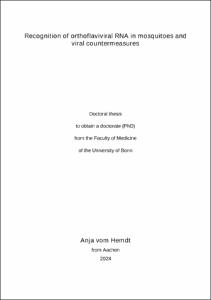vom Hemdt, Anja: Recognition of orthoflaviviral RNA in mosquitoes and viral countermeasures. - Bonn, 2024. - Dissertation, Rheinische Friedrich-Wilhelms-Universität Bonn.
Online-Ausgabe in bonndoc: https://nbn-resolving.org/urn:nbn:de:hbz:5-74921
Online-Ausgabe in bonndoc: https://nbn-resolving.org/urn:nbn:de:hbz:5-74921
@phdthesis{handle:20.500.11811/11348,
urn: https://nbn-resolving.org/urn:nbn:de:hbz:5-74921,
doi: https://doi.org/10.48565/bonndoc-235,
author = {{Anja vom Hemdt}},
title = {Recognition of orthoflaviviral RNA in mosquitoes and viral countermeasures},
school = {Rheinische Friedrich-Wilhelms-Universität Bonn},
year = 2024,
month = feb,
note = {Various infectious diseases are caused by mosquito-borne orthoflaviviruses affecting people worldwide. Efficient transmission of these viruses highly depends on the pathogen’s ability to overcome the host immune system. Previous studies showed that orthoflaviviruses evade the vertebrate immune system by capping their viral genome via a cap-N1-2’-O-methyltransferase encoded in the non-structural protein NS5. This thesis aimed to analyze whether orthoflaviviruses also escape the insect immune system by modulating their 5’ cap structure via 2’-O-methylation.
Using the yellow fever virus (YFV) vaccine strain (YFV-17D cap1) and a methyltransferase deficient mutant (YFV-17D cap0), this thesis demonstrates that the replication of YFV-17D cap0 is also impaired in mosquito cells. Since YFV-17D is unable to replicate in mosquitoes, a YFV-Asibi cDNA clone was additionally established to compare the respective cap1 and cap0 variants in vitro and in vivo. Similar to YFV-17D cap0, YFV-Asibi cap0 was suppressed in mosquito cells in a Dicer-2 independent manner but to a slightly lower extent. These data indicate that YFV-Asibi counteracts the insect antiviral discrimination mechanism of cap0 RNA. Studies comparing chimeras between YFV-Asibi and YFV-17D aimed to pinpoint the viral genes responsible for counteracting the discrimination mechanism. The results suggest that a synergy of several non-structural proteins is involved in this mechanism. In the case of YFV, the counteraction seems to be linked to a faster viral replication at early time points.
Furthermore, after oral infection of Aedes aegypti mosquitoes, YFV-Asibi cap1 replicated in the mosquito midgut and secondary tissues like legs plus wings. Conversely, replication of YFV-Asibi cap0 was suppressed in the midgut and nearly blocked in secondary tissues. Intriguingly, efficient replication of YFV-Asibi cap0 occurred after intrathoracic infection, indicating the existence of a potential receptor or protein discriminating between cap1 and cap0 RNAs in the midgut or the midgut barrier.
Since the methyltransferase is highly conserved between orthoflaviviruses, DENV cap0 was established as well. Comparative growth curve kinetics revealed that DENV cap0 replication is not suppressed in mosquito cells, implying that DENV also counteracts the insect antiviral discrimination mechanism of cap0 RNA but more strongly than YFV-Asibi.
In summary, the obtained results suggest the existence of an innate 5’ RNA-modification recognizing effector protein in mosquito cells and mosquitoes. Further, orthoflaviviruses counteract this effector protein by different means, leading to different levels of cap0 virus replication.},
url = {https://hdl.handle.net/20.500.11811/11348}
}
urn: https://nbn-resolving.org/urn:nbn:de:hbz:5-74921,
doi: https://doi.org/10.48565/bonndoc-235,
author = {{Anja vom Hemdt}},
title = {Recognition of orthoflaviviral RNA in mosquitoes and viral countermeasures},
school = {Rheinische Friedrich-Wilhelms-Universität Bonn},
year = 2024,
month = feb,
note = {Various infectious diseases are caused by mosquito-borne orthoflaviviruses affecting people worldwide. Efficient transmission of these viruses highly depends on the pathogen’s ability to overcome the host immune system. Previous studies showed that orthoflaviviruses evade the vertebrate immune system by capping their viral genome via a cap-N1-2’-O-methyltransferase encoded in the non-structural protein NS5. This thesis aimed to analyze whether orthoflaviviruses also escape the insect immune system by modulating their 5’ cap structure via 2’-O-methylation.
Using the yellow fever virus (YFV) vaccine strain (YFV-17D cap1) and a methyltransferase deficient mutant (YFV-17D cap0), this thesis demonstrates that the replication of YFV-17D cap0 is also impaired in mosquito cells. Since YFV-17D is unable to replicate in mosquitoes, a YFV-Asibi cDNA clone was additionally established to compare the respective cap1 and cap0 variants in vitro and in vivo. Similar to YFV-17D cap0, YFV-Asibi cap0 was suppressed in mosquito cells in a Dicer-2 independent manner but to a slightly lower extent. These data indicate that YFV-Asibi counteracts the insect antiviral discrimination mechanism of cap0 RNA. Studies comparing chimeras between YFV-Asibi and YFV-17D aimed to pinpoint the viral genes responsible for counteracting the discrimination mechanism. The results suggest that a synergy of several non-structural proteins is involved in this mechanism. In the case of YFV, the counteraction seems to be linked to a faster viral replication at early time points.
Furthermore, after oral infection of Aedes aegypti mosquitoes, YFV-Asibi cap1 replicated in the mosquito midgut and secondary tissues like legs plus wings. Conversely, replication of YFV-Asibi cap0 was suppressed in the midgut and nearly blocked in secondary tissues. Intriguingly, efficient replication of YFV-Asibi cap0 occurred after intrathoracic infection, indicating the existence of a potential receptor or protein discriminating between cap1 and cap0 RNAs in the midgut or the midgut barrier.
Since the methyltransferase is highly conserved between orthoflaviviruses, DENV cap0 was established as well. Comparative growth curve kinetics revealed that DENV cap0 replication is not suppressed in mosquito cells, implying that DENV also counteracts the insect antiviral discrimination mechanism of cap0 RNA but more strongly than YFV-Asibi.
In summary, the obtained results suggest the existence of an innate 5’ RNA-modification recognizing effector protein in mosquito cells and mosquitoes. Further, orthoflaviviruses counteract this effector protein by different means, leading to different levels of cap0 virus replication.},
url = {https://hdl.handle.net/20.500.11811/11348}
}





